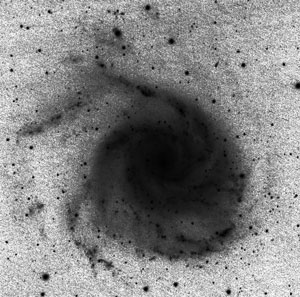|
Original
Old
The Pinwheel
galaxy (or M101 or
NGC5457) was
discovered by Pierre Méchain in March 1781.
M101 is a
relatively large galaxy compared to the Milky Way. With a
diameter of 170,000 light-years it is nearly twice the size
of the Milky Way. It has a disk mass on the order of 100
billion solar masses, along with a small bulge of about 3
billion solar masses.
Another remarkable property of this
galaxy is its huge and extremely bright H II regions, of
which a total of about 3,000 can be seen on photographs. H
II regions usually accompany the enormous clouds of high
density molecular hydrogen gas contracting under their own
gravitational force where stars form. H II regions are
ionized by large numbers of extremely bright and hot young
stars.
On photographs M101 can be seen to be
asymmetrical on one side. It is thought that in the recent
past (speaking in galactic terms) M101
underwent a near collision with another galaxy and the
associated gravitational tidal forces caused the asymmetry.
In addition, this encounter also amplified the density waves
in the spiral arms of M101. The
amplification of these waves leads to the compression of the
interstellar hydrogen gas, which then triggers strong star
formation activity.
Text taken from
Wikipedia.
 Event
though I managed to get a fair number of hours to stack, the
background contained some strange noise patterns. The reason
for the delayed "publishing" is the difficulty I have had in
processing the image while keeping the background under
control. Thus there are faint dust arms going out from the
galaxy present that I did not manage to show by stretching
without also stretching the noise pattern. Event
though I managed to get a fair number of hours to stack, the
background contained some strange noise patterns. The reason
for the delayed "publishing" is the difficulty I have had in
processing the image while keeping the background under
control. Thus there are faint dust arms going out from the
galaxy present that I did not manage to show by stretching
without also stretching the noise pattern.
In order to "hide" the
noise pattern I also had to apply a little too much
smoothing to the background, making it look a little
artificial.
Also I found that the
5min subs where substantially better than the 3min subs. The
reason may be due to different seeing conditions at
different nights but I suspect that 3min subs are a little
too short for the f-number used.
I am not completely happy
with the result considering the long integration time, but
still M101 has a very low surface brightness and if this
would have been a five hour image I would have been
satisfied with the result :-)
By
"mouse over" on the blue text just below the image you can
see:
-
Original: the most recently processed image.
-
Old: the previously processed image. I got the comment
from Bob Gilette that this one had a green cast which
led me to re-process (using a different white balance).
Thank you Bob!
An
enlarged (50% of original) can be viewed
here.
The
following software has been used. MaximDL (image
acquisition and guiding), CCDStack (calibration and de-convolution),
PixInsight (cropping, background correction, colour
corrections) and Photoshop CS5 (all the rest, incl Noel
Carbonis Astronomy Tools).
This
image was processed in February 2011 (the "old" was
processed in January 2011).
|

